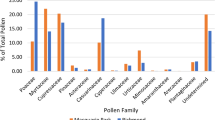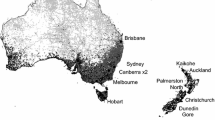Abstract
In Melbourne, Australia, airborne grass pollen is the predominant cause of hay fever (seasonal rhinitis) during late spring and early summer, with levels of airborne grass pollen also influencing hospital admissions for asthma. In order to improve predictions of conditions that are potentially hazardous to susceptible individuals, we have sought to better understand the causes of diurnal, intra-seasonal and inter-seasonal variability of atmospheric grass pollen concentrations (APC) by analysing grass pollen count data for Melbourne for 16 grass pollen seasons from 1991 to 2008 (except 1994 and 1995). Some of notable features identified in this analysis were that on days when either extreme (>100 pollen grains m−3) or high (50–100 pollen grains m−3) levels of grass pollen were recorded the winds were of continental origin. In contrast, on days with a low (<20 pollen grains m-3) concentration of grass pollen, winds were of maritime origin. On extreme and high grass pollen days, a peak in APC occurred on average around 1730 hours, probably due to a reduction in surface boundary layer turbulence. The sum of daily APC for each grass pollen season was highly correlated (r = 0.79) with spring rainfall in Melbourne for that year, with about 60% of a declining linear trend across the study period being attributable to a reduction of meat cattle and sheep (and hence grazing land) in rural areas around Melbourne. Finally, all of the ten extreme pollen events (3 days or more with APC > 100 pollen grains m−3) during the study period were characterised by an average downward vertical wind anomaly in the surface boundary layer over Melbourne. Together these findings form a basis for a fine resolution atmospheric general circulation model for grass pollen in Melbourne’s air that can be used to predict daily (and hourly) APC. This information will be useful to those sectors of Melbourne’s population that suffer from allergic problems.






Similar content being viewed by others
References
Andersen TB (1991) A model to predict the beginning of the pollen season. Grana 30:269–275
Asher M, Montefort S, Björkstén B et al (2006) The ISAAC phase three study group: worldwide time trends in the prevalence of symptoms of asthma, allergic rhinoconjunctivitis and aczema in childhood: ISAAC phases one and three repeat multicountry cross-sectional surveys. Lancet 368:733–743
BoM 2009. Climate statistics for Australian locations Bureau of Meteorology, Melbourne. http://www.bom.gov.au/climate/averages/tables/ca_vic_names.shtml
Cai WJ, Cowan TD (2008a) Evidence of impacts from rising temperature on inflows to the Murray-Darling Basin. Geophys Res Lett 35: L07701, doi:10.1029/2008GL033390
Cai WJ, Cowan TD (2008b) Dynamics of late autumn rainfall reduction over southeastern Australia. Geophys Res Lett 35(9):L09708. doi:10.1029/2008GL033727
Cai WJ, CowanTD, Raupach MR (2009) Positive Indian ocean dipole events precondition southeast Australia bushfires. Geophys Res Lett 36(19):L19710. doi:10.1029/2009GL039902; ISSN: 0094-8276
D’Amato G, Cecchi L, Bonini S, Nunes C, Annesi-Maesano I, Behrendt H et al (2007) Allergenic pollen and pollen allergy in Europe. Allergy 62:976–990
Davies R, Smith L (1973) Forecasting the start and severity of the hay fever season. Clin Exp Allergy 3:263–267
de Morton J (2009) Ryegrass pollen variability in the city of Melbourne. BSc Thesis, School of Earth Sciences, University of Melbourne
Egger J (1978) Dynamics of blocking highs. J Atmos Sci 35:1788–1801
Emberlin J, Savage M, Jones S (1993) Annual variations in grass pollen seasons in London 1961–1990: trends and forecast models. Clin Exp Allergy 23:911–918
Emberlin J, Mullins J, Corden J, Jones S, Millington W, Brooke M, Savage M (1999) Regional variations in grass pollen seasons in the UK, long-term trends and forecast models. Clin Exp Allergy 29:347–356
Erbas B, Chang J-H, Dharmage S, Ong EK, Hyndman R, Newbigin E, Abramson M (2007) Do levels of airborne grass pollen influence asthma hospital admissions? Clin Exp Allergy 37:1641–1647
Green B, Dettmann M, Yli-Panula E, Rutherford S, Simpson R (2004) Atmospheric Poaceae pollen frequencies and associations with meteorological parameters in Brisbane, Australia: a 5-year record, 1994–1999. Int J Biometeorol 48:172–178
Helbig N, Vogel B, Vogel H, Fiedler F (2004) Numerical modelling of pollen dispersion on the regional scale. Aerobiologia 20:3–19
Hill D, Smart I, Knox R (1979) Childhood asthma and grass pollen aerobiology in Melbourne. Med J Aust 1:426–429
Jato V, Rodríguez-Rajo FJ, Alcázar P, De Nuntiis P, Galán C, Mandrioli P (2006) May the definition of pollen season influence aerobiological results? Aerobiologia 22:13–25
Knox R (1993) Grass pollen, thunderstorms and asthma. Clin Exp Allergy 23:354–359
Lejoly-Gabriel M, Leuschner RM (1983) Comparison of air-borne pollen at Louvain-la-Neuve (Belgium) and Basel (Switzerland) during 1979 and 1980. Grana 22:59–64
Odgden EC, Raynor GS, Hayes JV, Lewis DM, Haines JH (1974) Manual for sampling airborne pollen. Hafner, New York
Ong E, Singh M, Knox R (1995) Grass pollen in the athmosphere of Melbourne: seasonal distribution over nine years. Grana 34:58–63
Russell G (2006) The childhood asthma epidemic. Thorax 61:276–278
Schäppi G, Taylor P, Kenrick J, Staff I, Suphioglu C (1998) Predicting the grass pollen count from meteorological data with regard to estimating the severity of hayfever symptoms in Melbourne (Australia). Aerobiologia 14:29–37
Taylor PE, Flagan RC, Valenta R, Glovsky MM (2002) Release of allergens as respirable aerosols: a link between grass pollen and asthma. J Allergy Clin Immunol 109:51–56
Uppala S, Dee D, Kobayashi S, Berrisford P, Simmons A (2008) Towards a climate data assimilation system: status update of ERA-Interim. ECMWF Newsletter 115:12–18
Vogel H, Pauling A, Vogel B (2008) Numerical simulation of birch pollen dispersion with an operational weather forecast system. Int J Biometeorol 52:805–814
Waller R, Sale P (2001) Persistence and productivity of perennial ryegrass in sheep pastures in south-western Victoria: a review. Aust J Exp Agric 41:117
Acknowledgements
We thank the Australian Bureau of Meteorology for providing meteorological data, the late Professor Bruce Knox (School of Botany, University of Melbourne) for the pollen counts from 1991–1996 and Dr. Eng Kok Benjamin Ong for the diurnal pollen counts from 1991 and 1992.
Author information
Authors and Affiliations
Corresponding author
Rights and permissions
About this article
Cite this article
de Morton, J., Bye, J., Pezza, A. et al. On the causes of variability in amounts of airborne grass pollen in Melbourne, Australia. Int J Biometeorol 55, 613–622 (2011). https://doi.org/10.1007/s00484-010-0361-x
Received:
Revised:
Accepted:
Published:
Issue Date:
DOI: https://doi.org/10.1007/s00484-010-0361-x




